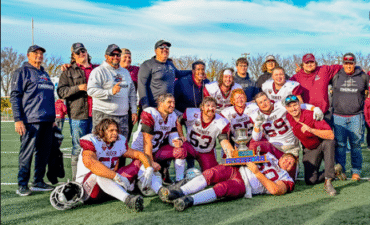
When Vancouver coach Guido Lamberti-Charles’ young players hit the ice, they don’t give much thought to how it feels under their skates.
“They just want to play,” Lamberti-Charles said.
But when he returned to Vancouver from coaching at development camps at Iowa State University in Ames, Iowa, and in Innsbruck, Austria, where the ice is made with vortex-treated water, the traditional ice made with hot water felt slow to him.
“I almost felt like I’m skating on concrete, I’m tipping over forwards,” he said.
Traditionally, rink operators fill a Zamboni with hot water, because heating drives out air and the resulting ice is harder.
But that good ice comes at a cost. At over 500 litres a fill, the water heating alone draws a lot of energy.
Then out on the ice sheet, the refrigeration system has to work to cool the water back down again before it can freeze to form a new ice surface.
The REALice system uses a vortex instead of heating to remove air. According to the company website, the 3D-printed valve has no moving parts, but uses existing water pressure to spin the water in a tornado-like vortex. Micro-bubbles of air move toward the lower pressure in the centre, becoming larger bubbles that will float out of the water once it flows into the Zamboni tank.
Improved ice quality from this technology could be a tough sell for community rinks across Saskatchewan, considering the large up-front investment of a vortex treatment system. But if the technology also saves money in the long run, that could be a different story, especially with shorter winters and a looming carbon tax pushing up energy costs for making ice.
Florian Gabriel, managing director with REALice’s technology transfer partner SWiCH Services Inc., said, “The de-aeration process [with vortex treatment] is actually more complete than heating up the water to what is traditionally done, at 140-160 F.”
Using cold water, according to REALice instructions, operators can keep the ice sheet 1 to 2 C warmer than required for freezing hot water. This saves energy use as well as wear and tear on compressor systems.
If a rink gets cold in frigid outdoor conditions, Gabriel said, the water could need some heating to keep from freezing too fast. In our cold Saskatchewan winters, that could cut down on the advantage of this system.
On the other hand, as winters get shorter, higher outdoor temperatures could be too much for some ice plants, especially when starting up the season in the fall. Gabriel said some operators are struggling to make good ice with traditional hot-water methods, since their ice-making plants were not designed for these new conditions. Using cold water could help them get by with an underpowered compressor.
Of course a heavily used urban rink will need more frequent ice floods, making the switch to cold water more valuable. At the other extreme, a curling rink uses very little water since the curlers don’t chop up the ice the way skaters do, so the advantage of cold water would be small.
So far, no arenas in Saskatchewan have installed the REALice system, although Gabriel said 46 systems have been installed across Canada. He said the economics vary by region, mostly due to different costs of electricity in different provinces. A map on the website shows numerous installations in B.C., Ontario and Alberta.
The City of Moose Jaw is considering a trial installation. Buildings and facilities manager Cory Oakes said he learned about the system while working in Strathcona County in Alberta, and seeing how it helped a facility in nearby Fort Saskatchewan.
He said the manager there took him through the pros and cons they had seen. “It was a quick turnaround, and their utility costs went down because there was a lot less humidity because they were using cold water versus hot water. But their struggle again was pinning down that initial cost.”
The cost, around $35,000, seems high for such a simple device. Gabriel said REALice 3D prints each unit, because a molding process doesn’t give the precision they need to create the vortex.
The device also has to withstand high pressure from the vortex, and even though it’s intended for use with cold water, it is made to resist high temperatures just in case somebody runs heated water through it.
“We always joke a little bit, that this thing will still run after the arena has already fallen apart,” he said.
Gabriel said REALice aims to have 1000 ice sheets using their system across Canada by 2022. They estimate the device saves an average of 50 tonnes of carbon dioxide emissions per sheet, per year. “With the long life of this product … we could really have a good impact with a very simple retrofit,” he said.
Coach Lamberti-Charles is thinking of the future, too. He said he is scared by the weather changes he has seen in the past two decades.
“If you can save resources for the planet by putting in a REALice tube, for me, that alone is worth it.”
Updated: an earlier version of this story reported 40 systems installed, mostly in B.C. and Ontario. The correct number is 46, mostly in B.C., Ontario and Alberta.














